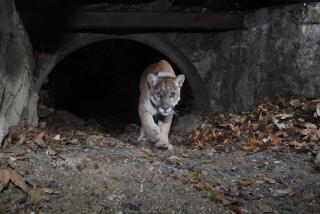Museum’s Lure to Be Man-Eating Lions
- Share via
TSAVO, Kenya — One night a century ago, a British army civil engineer killed a lion, ending a nine-month reign of terror and setting off wild jubilation by thousands of Indian railroad workers.
“They surrounded my eyrie [platform] and, to my amazement, prostrated themselves on the ground, saluting me with cries of ‘Mabarak! Mabarak!’ which I believe means blessed or savior,” Col. P.J. Patterson wrote in his 1907 bestseller, “The Man-Eaters of Tsavo.”
Patterson shot the lion’s mate a few weeks later.
The hunt for the lions was the subject of a recent Hollywood movie starring Michael Douglas and Val Kilmer, “The Ghosts and the Darkness.”
Now researchers from Chicago’s Field Museum of Natural History, where the preserved lions are on display, and from the National Museums of Kenya and the Kenya Wildlife Service are planning a Man-Eaters of Tsavo museum.
The lions’ bloody exploits made Tsavo, about 130 miles from the port of Mombasa, a familiar name when Kenya was a British colony.
David Western, director of the Kenya Wildlife Service, said the Tsavo museum will house exhibits about lions and items from a cave that Patterson dubbed the Lions’ Den, because he found human bones there.
“We want to use the man-eaters as a lure to get more people interested in Tsavo,” a 7,928-square-mile national park, Western said.
The park, straddling the main Mombasa-Nairobi highway, attracts fewer visitors than Kenya’s other animal reserves such as the Masai Mara. That is because it is difficult for visitors to Tsavo to see the “Big Five”--elephant, lion, Cape buffalo, leopard and rhino--in a single outing.
When Patterson shot the lions on Dec. 9 and 27, 1898, they had forced a three-week halt in the construction of the railway from Mombasa to Lake Victoria because the 3,000 workers were numb with fear.
“Their [lions’] methods became so uncanny, and their man-stalking so well-timed and so certain of success, that the workmen firmly believed they were not real animals at all, but devils in lions’ shape,” Patterson wrote.
Twenty-eight Indian workers were killed and eaten. Some accounts say at least 140 Africans living in the area were also killed.
Work on the 657-mile railway, carved through swamps, scrubland, savanna, forests and mountains, was begun in 1895 and completed six years later. Because Africans lacked the required skills, the construction company hired workers from India, then also under British rule.
The two museums and the Wildlife Service are looking for financing for the Tsavo museum. It would be located off the highway at Tsavo on a river of the same name.
The Lions’ Den, a short distance from the road, was rediscovered last May by Thomas Gnoske and Julian Kerbish of the Field Museum and Kenyan park rangers.
Some findings from the cave could be significant.
“Many of the well-known fossil sites that have yielded human remains in Africa were found in caves,” Kerbish said during a recent visit to the area.
A major caravan route from the Indian Ocean coast to the interior passed through Tsavo, and researchers hope the cave will yield evidence of the nature of the trade, which included slaves.
“To historically understand urban centers at the coast, one has to understand their relationship with the interior,” said Chapurukha M. Kusimba, a Kenyan who is an assistant curator at the Field Museum.
Bella Ochola-Wilson, a Wildlife Service official, said visitors will be escorted to the cave by armed rangers. Lions still roam in Tsavo.
More to Read
Sign up for The Wild
We’ll help you find the best places to hike, bike and run, as well as the perfect silent spots for meditation and yoga.
You may occasionally receive promotional content from the Los Angeles Times.






